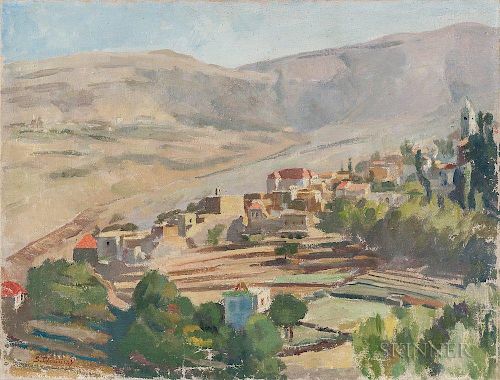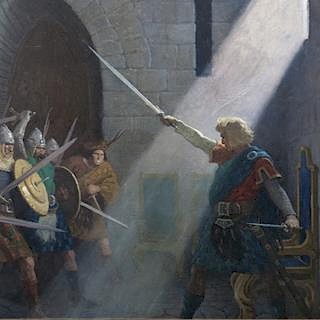Saliba Douaihy (Lebanese, 1915-1994) The Steppes of Lebanon
Lot 278
About Seller
Bonhams Skinner
274 Cedar Hill Street
Marlborough, MA 01752
United States
Founded over four decades ago, Bonhams Skinner offers more than 60 auctions annually. Bonhams Skinner auctions reach an international audience and showcase the unique, rare, and beautiful in dozens of categories, including the fine and decorative arts, jewelry, modern design, musical instruments, sc...Read more
Categories
Estimate:
$20,000 - $40,000
Absentee vs Live bid
Two ways to bid:
- Leave a max absentee bid and the platform will bid on your behalf up to your maximum bid during the live auction.
- Bid live during the auction and your bids will be submitted real-time to the auctioneer.
Bid Increments
| Price | Bid Increment |
|---|---|
| $0 | $10 |
| $100 | $25 |
| $500 | $50 |
| $1,000 | $100 |
| $3,000 | $250 |
| $5,000 | $500 |
| $10,000 | $1,000 |
| $30,000 | $2,500 |
| $50,000 | $5,000 |
| $100,000 | $10,000 |
| $300,000 | $25,000 |
| $500,000 | $50,000 |
| $1,000,000 | $100,000 |
About Auction
By Bonhams Skinner
Jan 26, 2018 - Jan 27, 2018
Set Reminder
2018-01-26 14:00:00
2018-01-27 14:00:00
America/New_York
Bidsquare
Bidsquare : Fine Paintings & Sculpture
https://www.bidsquare.com/auctions/skinner/fine-paintings-sculpture-2934
Bonhams Skinner bidsquare@bonhamsskinner.com
Bonhams Skinner bidsquare@bonhamsskinner.com
- Lot Description
Saliba Douaihy (Lebanese, 1915-1994)
The Steppes of Lebanon
Signed "S. Douaihy" l.l.
Oil on canvas, 19 3/4 x 25 3/4 in. (50.0 x 65.5 cm), unframed.
Condition: Unstretched, craquelure, flaking with paint losses l.c., rippling.
Provenance: Acquired directly from the artist at his home in Windham, New York, in the late 1970s.
Literature: Robert Wihbey, Saliba Douaihy, Artist, In Celebration of 100 Years (Springfield, MA: Saliba Douaihy Foundation, 2015), illustrated p. 21.
N.B. Born in the picturesque village of Ehden in the northern mountains of Lebanon, Saliba Douaihy displayed an early aptitude for drawing and left his hometown at age fourteen to study with artist Habib Shrour in Beirut. In 1932, Douaihy won a scholarship from the Lebanese government to study art in Paris. He spent the following four years exploring a variety of media, exhibiting his works in local galleries and exhibitions, and traveling in Europe.
Upon returning to Beirut, Douaihy worked on landscapes, portraits, and scenes of everyday life in Lebanon, often painting en plein air in the valleys and mountainous villages outside of the city. It was during this period that he likely painted The Steppes of Lebanon. Douaihy gained recognition in Lebanon, participating in national and international exhibitions including the Lebanese pavilion's display at the 1939 New York World's Fair.
In 1950, at the height of Douaihy's career, the Lebanese president selected the artist as a cultural ambassador for Lebanon to the United States and Mexico, a position the artist held for the rest of his life. He settled in New York City and worked in a variety of media, including stained glass. He also discovered the works of contemporary American abstract artists, including Mark Rothko, Hans Hofmann, and Ad Reinhardt, which influenced him to move away from his earlier academic style in favor of minimalist abstract paintings. By the end of the 1950s, Douaihy had turned entirely to the flat monochromatic forms, fine lines, and sharp edges that are evident in Lot 413.
After a one-man show in 1966 at the Contemporaries gallery in New York City, Douaihy gained recognition as an abstract artist. Subsequently, his works were included in exhibitions at the Museum of Modern Art, the Guggenheim Museum, and the Pennsylvania Academy of Fine Arts. In 1978, the North Carolina Museum of Art mounted a retrospective of the artist's work.
Douaihy's ouvre can be divided into three distinct genres: his early paintings of the Lebanese landscape and people, including the present lot; a series of ecclesiastical stained glass windows and murals that he completed for Maronite Churches in the United States and Lebanon; and the bright, minimalist abstract works, of which Lot 413 is a stunning example, that were his focus from the 1960s through the end of his career. We are fortunate to have examples from two of these genres included in this sale.
The Saliba Douaihy Foundation dates this work to the late 1930s or early 1940s, painted in Douaihy's Beirut, Lebanon, studio. A copy of Saliba Douaihy Artist, In Celebration of 100 Years, signed by the author and numbered "80/100," accompanies the lot. The proceeds from the sale of this work will contribute to the creation of a life-sized statue of Saliba Douaihy in his hometown of Ehden, Lebanon.
Estimate $20,000-40,000
The absence of a condition statement does not imply that the lot is in perfect condition or completely free from wear and tear, imperfections or the effects of aging. Condition requests can be obtained via email (lot inquiry button) or by telephone to the appropriate gallery location (Boston/617.350.5400 or Marlborough/508.970.3000). Any condition statement given, as a courtesy to a client, is only an opinion and should not be treated as a statement of fact. Skinner Inc. shall have no responsibility for any error or omission. - Shipping Info
-
Please visit http://www.skinnerinc.com/services/payment-and-shipping/ for information regarding the collection of items purchased at auction.
-
- Buyer's Premium



 EUR
EUR CAD
CAD AUD
AUD GBP
GBP MXN
MXN HKD
HKD CNY
CNY MYR
MYR SEK
SEK SGD
SGD CHF
CHF THB
THB











